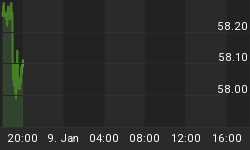Continuing my Elliott Wave series, I am going to be writing about the basics of Elliott Wave (EW). I want to keep this as simple as possible, because it is simple. The other objective I have for this series, is to make it relevant to trading. This is not for the academician, this is for the trader.
I will examine how EW analysis can be used to project turning points in the market.
I am going to cover Wave 3 and Wave C separately, although they have many similarities and could be covered together. Wave 3 belongs to a 5 wave impulsive structure. It is usually the longest and strongest (most momentum) of the impulsive waves (1, 3 & 5). If it is not the longest, it cannot be the shortest.
Our goal in trading a Wave 3 is to capture as much of it as possible. Ideally, we want to get in at the beginning of Wave 3 and get out before Wave 4 begins. Wave 4 is often a prolonged correction. We covered trading a W2, which would get us into W3 at its beginning, in a previous lesson. Assuming we are in a Wave 3 trade, what are the typical price targets? In order to calculate the price target for Wave 3, we need to first identify Waves 1 & 2. Then, using our Fibonacci extension tool, we click the beginning of Wave 1, then click the end of Wave 1, and finally click the end of Wave 2. A typical Wave 3 will be equal to the 161.8% projection of Wave 1 from the end of Wave 2. A maximum typical Wave 3 is the 261.8% projection of Wave 1. It is said that the minimal W3 projection of Wave 1 is 100%, but I find it rare that this is a Wave 3 with ES. If the wave ends at 100%, I find that it is usually a Wave C, and what we thought were W1 & 2 are relabeled Wave A & B. This often happens when we think a 5 wave impulsive move has completed and we enter a trade thinking we have bought the beginning of a new trend, only to find that we entered into the W4 of the impulsive move. That is why I always take some profits at the 100% level, whether I am in a corrective or impulsive wave.

Structure of Wave 3: A Wave 3 always subdivides into 5 waves. That is what we call the fractal nature of waves ~ or waves within waves. This does not help us differentiate a W3 from a Wave C though, because Wave C also subdivides into 5 waves. Occasionally, Wave C will take the pattern of an ending diagonal (ED), but Wave 3 never will.
Wave 3 Tips: Because Wave 3 is the strongest wave in a trend, you won't know when it will extend beyond your expectation. It is a good rule to always leave at least a runner to capture an extended move. The first significant correction in a W3 is usually W4 of W3. If you are trading a 1-5 minute chart, you may want to ride through that correction, if it's only going to amount to a few points.Remember what happens when you try a counter-trend trade in the face of a W3, and just ended up stepping in front of a freight train. Ride that train! Let your profits run. It's always best to let the market take you out of a W3 trade, IMO. To let the market take me out, I usually go to a 1 minute chart, and set a stop loss 1 tick below the last little swing low or high, depending on which way the trend is going.
W3 in actual market action: I am including this chart as an example of a W3, not because it is a classic looking impulsive wave, but to show a real-life example of what an impulsive wave might look like. When you are trading 1-5 minute charts, you will see more of these impulsive moves with wide swings and extreme moves. Also, note how the W4 of W3 probably fooled most EW traders into thinking that the W3 high was the W5 high, and end of the impulsive move. How many times have we seen this scenario in longer time-frames, when it looked like the top was in, but it was only the end of W3?
My next lesson will discuss Wave 4
If you like what you see here, wait to see how MortiES's analysis can assist you in your everyday investing or trading strategy! Go ahead., Click on "Subscribe to MortiES Premium" and give it a try! I am offering a 30 day free trial period.
















